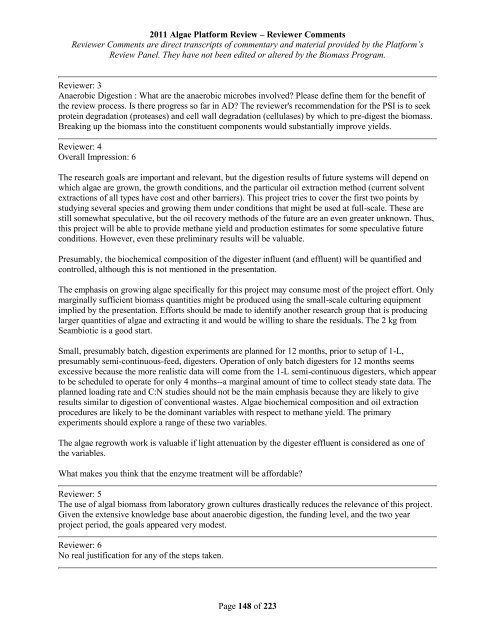Reviewer Comments - EERE
Reviewer Comments - EERE
Reviewer Comments - EERE
You also want an ePaper? Increase the reach of your titles
YUMPU automatically turns print PDFs into web optimized ePapers that Google loves.
2011 Algae Platform Review – <strong>Reviewer</strong> <strong>Comments</strong><br />
<strong>Reviewer</strong> <strong>Comments</strong> are direct transcripts of commentary and material provided by the Platform’s<br />
Review Panel. They have not been edited or altered by the Biomass Program.<br />
<strong>Reviewer</strong>: 3<br />
Anaerobic Digestion : What are the anaerobic microbes involved? Please define them for the benefit of<br />
the review process. Is there progress so far in AD? The reviewer's recommendation for the PSI is to seek<br />
protein degradation (proteases) and cell wall degradation (cellulases) by which to pre-digest the biomass.<br />
Breaking up the biomass into the constituent components would substantially improve yields.<br />
<strong>Reviewer</strong>: 4<br />
Overall Impression: 6<br />
The research goals are important and relevant, but the digestion results of future systems will depend on<br />
which algae are grown, the growth conditions, and the particular oil extraction method (current solvent<br />
extractions of all types have cost and other barriers). This project tries to cover the first two points by<br />
studying several species and growing them under conditions that might be used at full-scale. These are<br />
still somewhat speculative, but the oil recovery methods of the future are an even greater unknown. Thus,<br />
this project will be able to provide methane yield and production estimates for some speculative future<br />
conditions. However, even these preliminary results will be valuable.<br />
Presumably, the biochemical composition of the digester influent (and effluent) will be quantified and<br />
controlled, although this is not mentioned in the presentation.<br />
The emphasis on growing algae specifically for this project may consume most of the project effort. Only<br />
marginally sufficient biomass quantities might be produced using the small-scale culturing equipment<br />
implied by the presentation. Efforts should be made to identify another research group that is producing<br />
larger quantities of algae and extracting it and would be willing to share the residuals. The 2 kg from<br />
Seambiotic is a good start.<br />
Small, presumably batch, digestion experiments are planned for 12 months, prior to setup of 1-L,<br />
presumably semi-continuous-feed, digesters. Operation of only batch digesters for 12 months seems<br />
excessive because the more realistic data will come from the 1-L semi-continuous digesters, which appear<br />
to be scheduled to operate for only 4 months--a marginal amount of time to collect steady state data. The<br />
planned loading rate and C:N studies should not be the main emphasis because they are likely to give<br />
results similar to digestion of conventional wastes. Algae biochemical composition and oil extraction<br />
procedures are likely to be the dominant variables with respect to methane yield. The primary<br />
experiments should explore a range of these two variables.<br />
The algae regrowth work is valuable if light attenuation by the digester effluent is considered as one of<br />
the variables.<br />
What makes you think that the enzyme treatment will be affordable?<br />
<strong>Reviewer</strong>: 5<br />
The use of algal biomass from laboratory grown cultures drastically reduces the relevance of this project.<br />
Given the extensive knowledge base about anaerobic digestion, the funding level, and the two year<br />
project period, the goals appeared very modest.<br />
<strong>Reviewer</strong>: 6<br />
No real justification for any of the steps taken.<br />
Page 148 of 223




